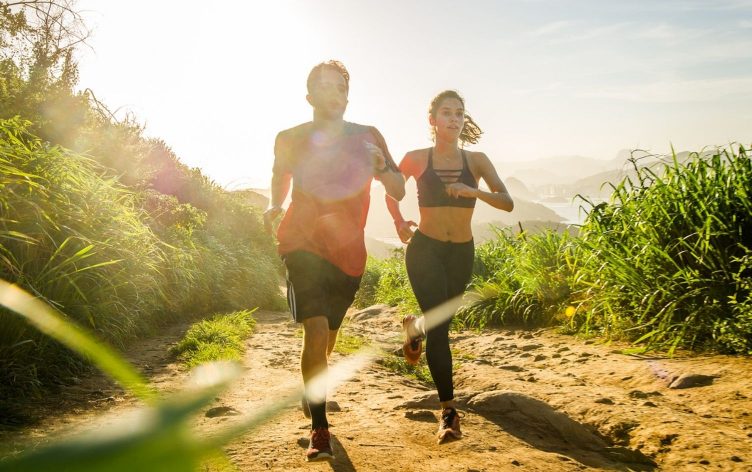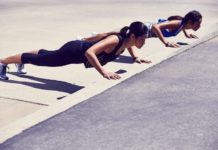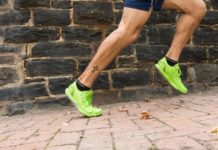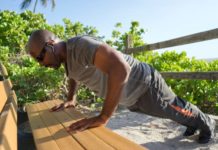
How to Dress for Warm Weather Walks and Runs
Walking or running in the heat can feel terrible — and near impossible to dress for. All that sweat? The potential for sunburn? The chafing? Yikes. But there’s good news: Our bodies are awesome at thermoregulation, for the most part. And research has shown the more aerobically fit you are, the better your body is at handling hot temperatures. But what about those first few weeks of walking or running if you’re new, or those days when it feels like you’re exercising in a sauna? That’s where your wardrobe can play a big role in your overall comfort and in how efficiently you’ll be able to exercise.
Use these expert tips to strategically pick your workout clothing and accessories in order to stay safe and active throughout the hottest months of the year.
UNDERSTAND “REAL FEEL” TEMPERATURE
Not all heat is created equal: High humidity can make the effects of heat significantly worse by dampening (pun intended) the rate at which sweat can evaporate off your body, says Christopher Minson, a professor of human physiology at the University of Oregon. Sweat isn’t just an annoyance that happens when you’re getting hot, it’s the body’s way of cooling itself, and the cooling effect only happens when the sweat can evaporate. In high humidity, sweat sticks around.
Added to that, the harder you have to work to cool your body, the hotter you’ll feel. “If I’m riding my bike, I won’t feel nearly as hot as I will when I’m running,” says Minson. “That’s because the air flow is helping the sweat to evaporate, and when I’m running, I’m much less efficient.”
If you live in a humid area, just assume it will always feel a few degrees warmer than the actual temperature, and dress accordingly. To get a more precise idea of how hot it really is, use the National Weather Service’s Heat Index calculator to plug in the temperature and humidity to get an accurate read on exactly what kind of heat you’re dealing with.
LEARN YOUR TOLERANCE
Every person has a different tolerance for heat, so it’s important to dress for your own needs rather than copying exactly what your exercise partners are wearing. Some heavy sweaters find wearing long sleeves impossible since they soak through quickly, while a more mild sweater can walk for an hour or more in long sleeves in 100-degree weather and feel safe from the sun instead of drenched. “Everyone will have a different reaction to different heats,” says Minson. “And the more time you spend exercising in heat, the more your body will adapt.”
To figure out your heat tolerance, start to take notes after your workouts. Use an app like MyFitnessPal to track your exercise and take notes about the type of workout (duration and how hard it was) you did, how hot it was and what you wore. Eventually, you’ll start seeing patterns emerge and be able to create your own mini-clothing matrix that helps you decide what to wear for each workout.
CLICK TO TWEET THIS ARTICLE > Dress for success during hot weather workouts with these tips from @myfitnesspal.
To get you started, here’s what to think about as you prep to walk or run in a range of warm temperatures:
1. SHADE YOUR FACE
Invest in a breathable, sweatproof cap that provides UV protection, keeps the sun off your face and scalp, and helps to keep sweat out of your eyes. You may prefer wearing a headband or buff to keep hair off your face, or no cap at all if you have short hair, but if you do that, be aware your scalp is getting a lot of sun exposure.
2. UV PROTECTION FOR YOUR EYEBALLS
Sunglasses are important if you’re rarely in the shade, as they’ll protect your eyes from the sun’s rays as well. Look for lenses that offer UV protection: Some cheaper ones won’t, but you don’t need to buy ultra-pricey glasses to get SPF ratings. Goodr‘s sport sunglasses are only $25 and offer UV 400 protection.
3. TOP IT OFF
In all warm weather (or any weather, really!), make sure any exposed skin has sunscreen covering it. An easier way to avoid sunburn is by simply covering up what you can, while still allowing your skin to breathe and cool itself. Thankfully, many athletic brands are making ultra-lightweight clothing options that provide UV protection while wicking moisture and keeping you as cool in long sleeves as you’d be in a tank top. “There isn’t a fabric that works as well for sweat-wicking as just having bare skin,” says Minson. “But covering skin for protection from the sun’s radiation is important as well.”
Clothing is the best way to protect your skin from the sun, according to the Skin Cancer Foundation. But make sure the clothing you’re wearing actually has UV protection: A plain white cotton T-shirt is only rated at around SPF 7, which is minimal protection. On the other hand, some athletic clothing offers built-in SPF 50 (like these from Under Armour and Columbia). If you’re out for a long run or walk, but won’t be going too hard, consider wearing a long-sleeve running shirt that offers UV protection. This saves you from the need to reapply sunscreen halfway through.
4. CHECK YOUR FABRICS
Opt for light and minimal when it comes to clothing. Slather on plenty of sunscreen, and then let air hit your skin as much as possible to speed the cooling process. When it comes to fabric choice, the lighter the better, and most people prefer a tighter fit. While a loose fit might feel great to start, if you’re a heavy sweater, the fabric will start to soak and weigh you down, flap around and even chafe if it’s too loose. “Most companies are opting for more fitted cuts for hot weather,” says Minson. “If you’re not working hard, looser clothing will provide more air flow. But if you’re going to be working hard, once loose clothing gets wet, it’s much more prone to chafing.”
The shorts and tank top that felt fantastic in 60º weather may not serve you well in 90º heat. Look for fabric that boasts moisture-wicking properties. And definitely skip that cotton T-shirt, which will end up soaked and suffocating in a matter of minutes.
One final warning: Many lightweight tank tops are made with a fine mesh that offers little UV protection, so put sunscreen on your torso!
5. CHECK YOUR SEAMS
On a shorter or cooler walk or run, the seams on your shorts, sports bra or shirt may not be as noticeable or irritating. But add heat, sweat and time, and you may start to feel chafing. There are a few ways to ease the irritation. First, check where the seams are bothering you. Is it just one pair of shorts that’s leaving an angry welt on your inner thigh? Relegate those to ‘cooler weather only.’ If it’s most shorts, consider trying a different length of shorts, or use a chafe-proof stick (similar to deodorant but designed to fight friction instead of smelly sweat). You can also try a DIY on your clothing by putting a small piece of cloth tape over the seam that’s bothering you.
6. BELIEVE IN YOUR CLOTHING CHOICES
This might sound a little out there, but your self-talk can determine your comfort levels. Researcher Stephen Cheung of Brock University found using positive self-talk helped decrease discomfort when exercising in hot conditions. So, next time you find yourself stressing that you wore the wrong type of shirt for the run, switch the station and tell yourself, ‘I’ve got this.’ (And remember that if you’re feeling overdressed, studies have found training in more clothing than needed is great for later heat adaptations — so, it’s actually helping you in the long run!)
7. BYO(W)B
A handheld water bottle is a good idea to bring along, even if you don’t think you’ll need it. The ability to take a few sips to cool down, or splash your face and wrists with cold water if you’re getting overheated, can be the difference between heat exhaustion and being able to get home without any problems.
8. TAKE PRECAUTIONS IN 90+ DEGREE HEAT
A hydration vest, pack or belt is a must if you’re going for a long or hard workout in this kind of heat. Add as many ice cubes as you can so you have access to cold water throughout your walk or run, and have enough water to drink at least 20 ounces each hour (or have a plan to refill). Pick your clothing to fit comfortably with your pack of choice. For many, a tank top with a vest or pack is uncomfortable and can lead to shoulder chafing, so a short-sleeve or long-sleeve shirt is a safer bet. But again, look for one designed for hot-weather exercise.
In addition, it’s important to keep a very close watch on your heart rate and how you’re feeling for longer or harder efforts. Don’t be afraid to dial back to an easier workout, and save the tough stuff for a cooler day.
“Build up slowly,” advises Minson. “Early in the season, you may find that a short run in 70 degree weather feels like it’s boiling. But by August, that same run will feel completely fine if you’ve been walking or running consistently.”
9. PAY ATTENTION TO SIGNS OF HEAT STROKE
Remember, it’s important to take heat — and your body’s warning signals about it — seriously. If you feel as though you’re starting to exhibit any signs of distress: heat cramps, sudden fatigue, headaches, weakness, nausea, confusion, clammy skin or a spiking heart rate that doesn’t coordinate with your exertion level can all be signs you’re in danger of suffering from heat exhaustion or heatstroke, according to the Mayo Clinic.
THE BOTTOM LINE
While hot weather certainly isn’t the most pleasant to exercise in, it’s totally possible to stay active (and safe) during the sweaty months. Just prepare appropriately and stay vigilant of your body’s feedback during exercise, and you should be just fine.
Make progress every day while you work on fitness and nutrition goals, like walking more steps. Go to “Plans” in the MyFitnessPal app for daily coaching and easy-to-follow tasks to keep you motivated.
































